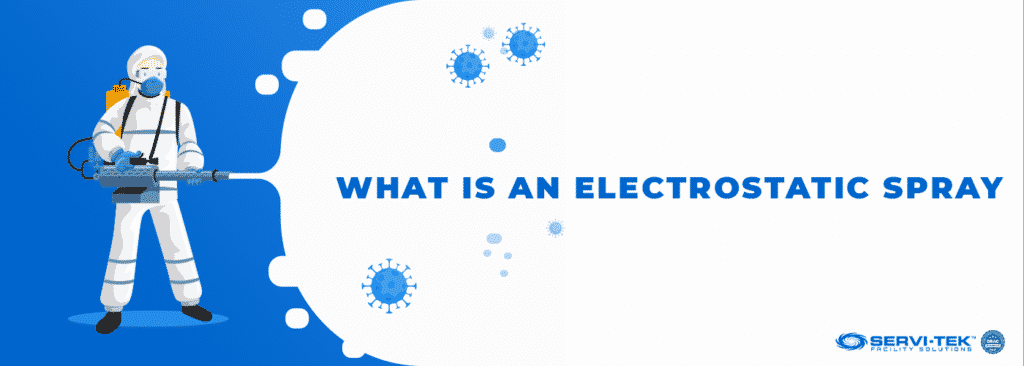
Being a facility manager during and after the COVID pandemic is not an easy job.
Besides the regular activities, one of your most important tasks is to prevent or slow down the spread of viruses, germs, bacteria, and other pathogens and contaminants.
Alone, it is an impossible task. This is why you should consider partnering with experts and top market technologies. However, it is recommended that you work with a service provider that is Global Biorisk Advisory Council (GBAC) certified. This is the cleaning industry’s only outbreak prevention, response, and recovery accreditation for all types of facilities.
Electrostatic disinfection has been gaining popularity and is used in all kinds of commercial facilities. How does it work, and is it the right choice for your business?
Find out all about it here.
What Is an Electrostatic Spray?
Electrostatic spray disinfection uses negative or positive charged particles to emit droplets of disinfectant, which fully reaches the undersides and backsides of surfaces.
Electrostatic spraying is not a new technology itself, as other industries have long used it for painting and other tasks.
Among the many disinfection methods, electrostatic disinfectant sprayers ensure a complete coating and effectively kill germs when given sufficient contact time.
Electrostatic disinfection services are offered by traditional commercial cleaners, janitorial service providers, and others that provide on-site workplace assistance.
How An Electrostatic Spray Disinfectant Works
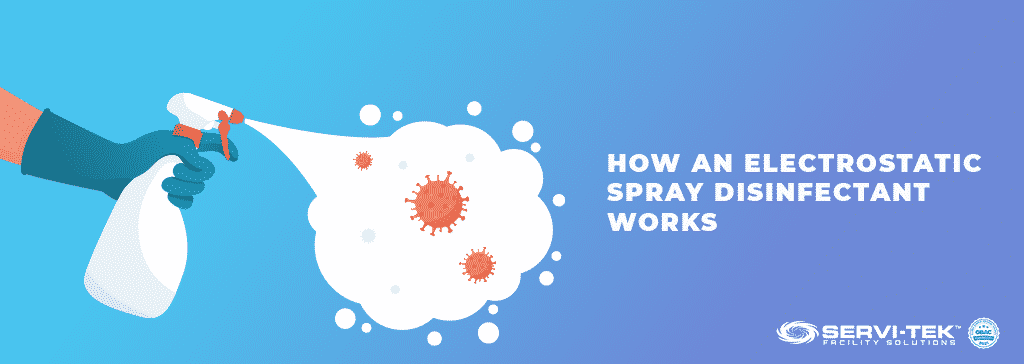
Demand for electrostatic disinfection work will continue to rise. Contaminated surfaces in high-traffic commercial buildings are a concern because of the potential to spread COVID-19 and other viruses.
Electrostatic disinfection is one means of eliminating pathogens, particularly across large areas where manual disinfection is inefficient.
Electrostatic sprayers work by charging liquids as they pass through a sprayer nozzle.
This produces charged droplets that reject each other and actively seek out ambient surfaces, to which they adhere and evenly wrap around to coat all sides.
As a result, sprayed objects get a consistent coating of sanitizer or disinfectant, even hard-to-reach spots that hand cleaning can miss. The technology also helps to prevent liquid pooling, which is a common problem with sprayers.
What Kind Is Best?
Electrostatic sprayers are often classified according to either the power source or means of transporting the device.
For example, electrostatic sprayers are available in either battery-powered or A/C powered configurations, which have varying strengths and drawbacks.
The battery-powered models are largely seen as more efficient and portable because they are not reliant on a charging plug. Although the battery technology has improved, these models may perform inconsistently due to a lack of steady power.
Alternatively, the machine that plugs into an outlet (A/C) maintains continuous power levels, but the cord is often inconvenient.
The three primary categories relating to portability include handheld, backpack, or roller cart models.
The handheld models generally have a maximum tank size of 34 ounces and can cover 5,000 square feet per hour.
Backpack devices can carry one gallon or more of disinfectant and can cover roughly 50,000 square feet per hour.
The roller cart models have approximately the same capacity as the backpack model but reduce the strain of transporting the unit.
To simply say that a specific type or category of electrostatic device is the best fails to consider the variables. The key in choosing a machine, accessories, and disinfectant involves finding the best choice for the given application.
The solution you choose should be based on factors including the layout of the space—particularly the size. You must also determine the frequency of application and how this corresponds to the hours of building occupancy.
The durability of the equipment and warranty coverage might be primary considerations when the device is used daily or weekly. The weight and portability of the machine are critical considerations when the machine must be transported on different floors.
A professional that has experience using this type of technology will first assess your specific needs. After making a detailed assessment, you will have the information necessary to make the best choice for the job.
What Surfaces Can They Be Used On?
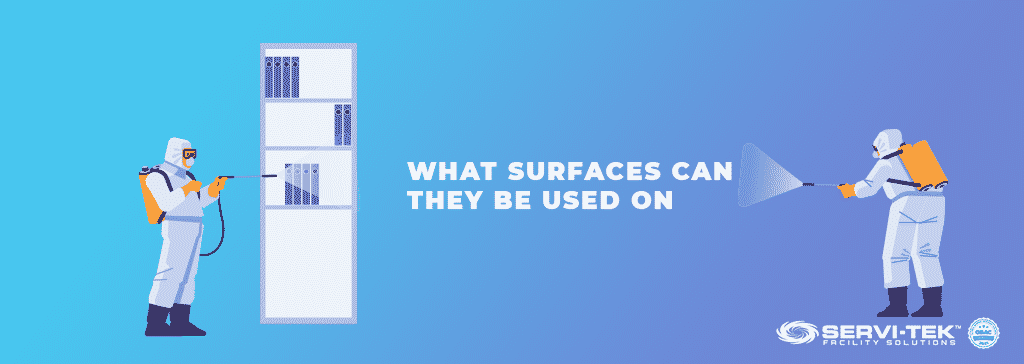
Electrostatic disinfection can be used across a wide variety of surfaces, particularly those with a solid finish. Here’s how the technology applies to each type of area:
1. How They Work on Hard Surfaces
Electrostatic disinfection has proven to be highly effective on most hard, non-porous surfaces found in commercial settings.
Keep in mind that surfaces made of wood should not be sprayed directly at close range.
The cleaning products used may fade or otherwise degrade some surface types found in office furniture. This applies predominately to those that are not designed for powerful disinfectants and have seams.
2. How They Work on Soft Surfaces
Most electrostatic spraying models can be used safely in the proximity of many soft surfaces, but with caution. Many types of durable upholstery will withstand the force of a spray from a distance—but the close application is not recommended.
Generally speaking, electrostatic disinfection is not the best option for soft surfaces, particularly among materials that can be laundered.
Also, electrostatic sprayers may leave a residue or create damage to paper documents and similar materials.
3. How They Work on Electronics
Electrostatic disinfection can be used safely near computer equipment such as monitors or keyboards. However, electronic equipment should not be sprayed directly from a close range.
What Makes Them So Effective?
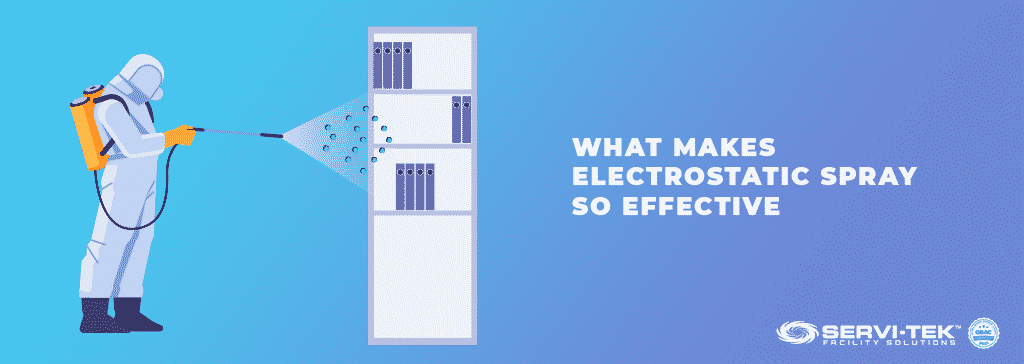
Disinfectants are almost taken for granted today in terms of their ability to eliminate harmful germs. But not all substances work the same way and largely depend on the ingredients, the concentration, and the means of application.
Here’s how electrostatic disinfectants work and what you should pay attention to:
1. Electrostatic Spray Disinfectants Kill by Destroying the Cell Membranes of Micro-Organisms
Disinfectants generally kill organisms by disrupting their structure. Alcohol is a common example that encourages clumping among cell proteins where the cell membranes collapse.
For a better effect, alcohol is generally mixed with water for dilution.
Chlorine is another common disinfectant that is added to drinking water to eliminate bacteria. It works through oxidation and when mixed with water it creates an acid that kills bacterial cells.
2. Electrostatic Spray Products Work on Malodors, Not Bacteria
Electrostatic spray products have proven effective against malodors, also known as unwanted odors because they destroy the spores that generate the smell.
Although electrostatic products are effective on most germs, bacteria, and viruses, they won’t prevent long-term re-infection. This is why regular disinfection is a must, especially in large, highly-used commercial facilities.
3. Direct, Persistent Application Is the Key
Electrostatically applied disinfectant has shown to be very helpful in healthcare settings in recent years.
Hospital-acquired infections (HAIs) are an important topic, as CDC estimates that on any given day, about one in 31 hospital patients has at least one associated infection.
In more recent years, the number of annual HAIs has decreased due to the implemented safety measures.
Disinfectants are best applied directly, including those sprayed using an electrostatic device.
Direct application refers to ensuring that no objects obstruct or impede the substance’s ability to reach the target surface.
4. Use Products With Uncapped Dead Air Space
The Coronavirus pandemic renewed concerns regarding contracting diseases through airborne transmission.
Dead air space lacks any ventilation. Commercial environments are encouraged to eliminate dead air space when harmful pathogens are dispersed.
You can reduce harmful airborne particles in your facility through proper filtration, a constant flow of fresh air, and ultraviolet lighting (UV).
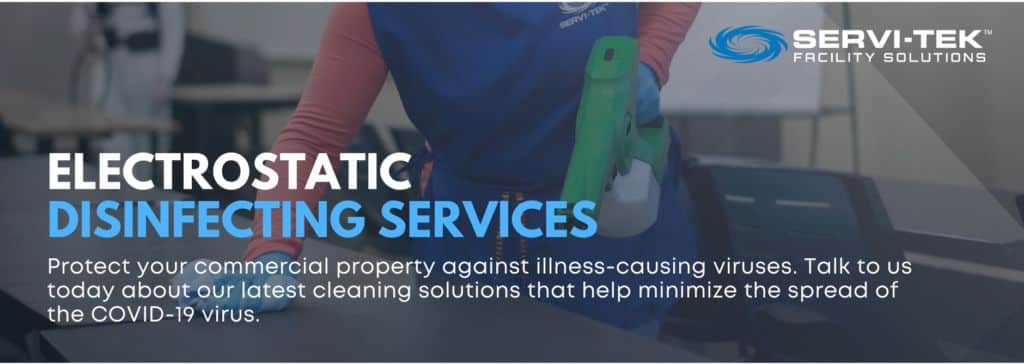
Effectiveness Of Electrostatic Spray Disinfectants for Healthcare Facilities
If you manage a healthcare facility, then you are encouraged to approach electrostatic disinfection in much of the same way as other settings.
The key first step is choosing an approved disinfectant from the EPA’s most updated compilation of options.
Many medical facilities consider a sporicidal product that has proven to be effective against C. difficile for patient safety. Another aspect to consider is whether the sprayer has a sufficient source of power.
This would particularly be a concern for battery-powered models that might not deliver sustained power. Also, electrostatic disinfection would be inappropriate for use in any rooms or spaces currently occupied by a patient.
Effectiveness Of Electrostatic Spray Disinfectants for Offices
Electrostatic sprayers are effective in office environments for several reasons.
First, these settings contain electronics and lots of individual workspace areas that may potentially have hard-to-reach corners where germs thrive best.
Offices also tend to operate primarily during business hours, which allows for a nightly or weekend application. Not having to worry about wiping down the surfaces is another benefit for office use.
Traditional cleaning methods, particularly on regularly used office surfaces, are still important for improving overall effectiveness. Cleaning is necessary to remove surface dirt or grime that may obstruct the disinfection process.
Effectiveness Of Electrostatic Spray Disinfectants with Humidity
When evaluating proper disinfection techniques, it’s crucial to consider not only the spray distance but also the room’s temperature and relative humidity.
The type of materials used and the relative humidity in the surroundings influence the electric field created. As the relative humidity drops, the electric field strength increases and the chemicals dispersed better adhere to the surface.
When Do You Use an Electrostatic Spray Disinfectant Vs Another Method?
Decisions regarding whether a workplace setting is appropriate for electrostatic disinfection are based on the circumstances.
Applications that may pose challenges include densely populated areas where the air is heavily recycled, or closed, small spaces.
The CDC’s primary areas of concern thus far have been avoiding use near food preparation areas or close to children.
Tips For Using Electrostatic Disinfectant Sprayer Effectively
Electrostatic spraying devices that are battery-powered should be fully charged for best results. Ensure that the unit contains the proper labeling that suggests compliance with federal regulations.
Most models will have a label with instructions located on or near the reservoir or tank that holds the chemicals. In many cases, the disinfectant must be diluted with water and no other substances should be added.
If you’re not sure what is best for your facility when using an electrostatic disinfectant sprayer, check the following tips:
1. Selecting the Proper Disinfectant
Some of the most often used types of disinfectants include quaternary ammonium compounds, bleach, hydrogen peroxide, and alcohol. Quaternary ammonium compounds (QACs) are powerful against COVID-19.
Keep in mind that QACs should be used with caution, as they can irritate the skin and trigger reactions among those with asthma. Bleach is a common disinfectant that usually has a concentration of 5 to 10% sodium hypochlorite when purchased from retailers.
The EPA’s List N contains several disinfectants that mention sodium hypochlorite or bleach as an active ingredient.
Also follow the instructions, in many cases, a fresh mixture should be made for each different day.
Bleach is another substance that can pose risks when exposed to the skin or eyes and can create rust when used on certain metals.
Despite being a powerful oxidizer, hydrogen peroxide is among the safest options because it breaks down into water and oxygen.
Isopropyl alcohol and ethanol are also popular choices because they evaporate without leaving much residue.
In some cases, alcohol solutions evaporate too quickly to follow the required surface dwell time and a second application is needed.
2. Selecting the Proper Spray Unit
Disinfectants have traditionally been applied using different types of sprayers. The most simplistic is a manual pump-style sprayer that disperses the liquid as a mist.
The manual pump-style sprayer can be upgraded to a pressurized container model. While effective for rather small applications, the stream will lose pressure after use and its efficiency will notably decrease.
Pump sprayers can also be activated by an electric motor that takes the disinfectant and creates a stable spray volume.
Meanwhile, electrostatic models often use a disinfectant with a positive charge for application on surfaces with a negative charge.
Electrostatic sprayers have been shown to conserve disinfectant and different models allow for varying the droplet size. Larger size droplets are considerably more likely to improve surface coverage and dwell for a longer period before evaporating.
3. Selecting the Proper Wand
Wands are either included with various electrostatic devices or added as an optional accessory. You can find on the market extensions that are compatible with both the handheld and backpack models.
You can also find induction rings considered “high voltage” and intended for hydraulic sprayers. Hydraulics allow a device to spray with sufficient force needed to reach and cover the undersides or backsides of larger objects.
When pondering your options, it is best to talk to specialists. They will know, based on your particular needs, what would be the best choice.
4. Applying the Disinfectant Correctly
This is a common error that inexperienced users make.
Emphasis is placed on reading and adhering to the manufacturer’s instructions for preparation and application.
Users of electrostatic sprayers must be properly equipped with personal protective equipment (PPE). Proper surface preparation involves cleaning to remove any dirt or material that could limit the ability to disinfect.
Application Guidelines
The application process when using an electrostatic device is simplified, as the positive and negatively charged particles adhere and coat uniformly.
Proper mix ratios guidelines are provided by BC Centre for Disease Control, however, depending on the application surface, materials, facility size, infection spread, etc., the rations significantly differ and an expert is the only one authorized and able to correctly advise you.
Before starting, the most crucial step of the process is to clean off any existing surface material using a detergent and water.
After disinfection, cleaning the nozzle to remove any existing residue is necessary.
How to Properly Maintain and Take Care of Sprayers and Sprayer Nozzle
The most important maintenance task is rinsing out the nozzle using clean water shortly after each use, which is effective in preventing buildup.
When buildup occurs, the machine is likely to clog and spray unevenly. Periodically, disassemble the nozzle device for a more thorough cleaning and check for any corrosion on the electrode.
This model of sprayer is also equipped with an air filter that is used for capturing incoming air particles. The filter should be changed after the machine has been used for 1,000 hours.
Environmental Considerations
Unlike many traditional or manual methods of disinfection, electrostatic spraying has proven to conserve the cleaning agent and reduce waste.
Some comparable methods that lack a charge are more susceptible to over spraying, which will generate particles that reach food, skin, and breathing air and can lead to significant health issues.
The most critical aspect that determines the environmental impact of any electrostatic spraying device is the choice of disinfectant.
Green chemical solutions are increasingly being introduced in the commercial cleaning market today and electrostatic devices are no exception.
Keep in mind that the EPA does offer safety and environmental guidelines for disinfection products.
However, they regulate the agents or chemicals themselves—not the method of dispersal including electrostatic applicators.
Experienced Commercial Cleaning and Disinfection Company
At Servi-Tek Facility Solutions your business is our priority.
Our team of specialists continues to create and innovate while providing comprehensive services for commercial facilities.
We develop customized disinfection strategies for clients to eliminate the spread of germs, particularly in common and high-traffic areas.
Contact us today for a free facility walk-through, expertise, and advice directly from market professionals.




